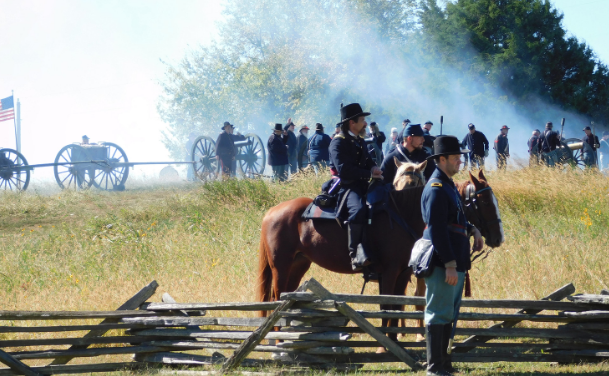By Mark Maynard
Kentucky Today
Battlefield tourism has become an important part of Kentucky’s economy. The Kentucky Civil War Sites Association says visitors to battlefields and related attractions spent more than $10 million last year in the state.
The group says in a newly released report to lawmakers that people came from across the country and several foreign counties last year to visit Kentucky’s battlefields. Abraham Lincoln’s birthplace and the Jefferson Davis State Historic Site were also popular among visitors. Visitors spent an average of $258 in the communities they visited in literally every region of the state, with lodging and food accounting for about half of that.

Perryville Battlefield is a popular Civil War site for re-enactors and visitors. Battlefield tourism has brought in $10 million to Kentucky, according to a study. (Perryville Battlefield photo)
Joni House, the president of the Kentucky Civil War Sites Association, said the study proved the economic value of the battlefields and historic sites in the state.
“It shows very clearly the amount of money that heritage tourism brings into the state,” she said. “That’s a big number for 26 sites surveyed.”
Revolutionary War and Civil War battlefields were all that were surveyed, she said.
“These are huge, huge numbers as an economic driver for Kentucky,” she said. “I didn’t know how much until we got the survey back.”
The survey doesn’t take into account the dozens, if not more, Civil War sites that weren’t battlegrounds located throughout the state, she said. “I couldn’t even begin to tell you how many there are.”
House, who is the manager of the Perryville Battlefield site, said while the dollars are important there’s more at stake.
“While it’s no doubt one of our top industries, it’s not just the money,” she said. “It’s also a responsibility for all of us who are stewards of our past. They truly have defined us.”
Adam Gillenwater, State and Local Relations Manager at America Battlefield Trust, is wanting the General Assembly to consider studying the battlefield preservation needs in Kentucky and develop a report for a path forward to establish a fund.
“We’d like to look at what has been done in some other states who have dedicated funding streams for battlefield preservation and hope it can be a model for Kentucky,” Gillenwater said.
Preserving the battlefields need to be preserved before they disappear and that investing in that reaps its own dividends, he said.
“These are hallowed grounds that now only tell the story of our country but provide an economic impact.”
The Kentucky study is further proof of how it can be a tourism boost, said James Lighthizer, president of the Amercian Battlefield Trust.
“The study commissioned by the Kentucky Civil War Sites Association further confirms what we have long known – Kentucky’s preserved battlefields are economic engines that draw high-value visitors, provide jobs, and turn tourism dollars into revenues for state and municipal coffers,” he said. “Beyond heritage tourism, these sites also serve as ‘outdoor classrooms,’ providing tangible links to our nation’s past. While the American Battlefield Trust is proud of the 2,500 acres we have helped save in the Bluegrass State, much more work remains to be done. State funding for battlefield preservation, matched with federal and private sector dollars, will help ensure that these sites’ lasting economic and historic contributions remain for the benefit of current and future generations.”
Here are a few other facts from the survey:
–The majority of visitors traveled more than 200 miles to experience the sites.
–Out-of-state tourist spending boosts the state’s GDP by $7.1 million.
–Nearly two-thirds of Kentuckians surveyed (65 percent) strongly support the use of tax dollars being spent to preserve Kentucky’s battlefields and related historic sites in the state.
–The sites generate more than $1 million in state and local tax revenue from out-of-state visitors.


















